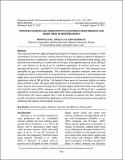| dc.description.abstract | This study assessed the effect of applying inorganic or organic sources of nitrogen, or their combination, on N2O emission, maize yield and Nitrogen Use Efficiency (NUE) at Nyakach, a lowland and Soin, a highland in western Kenya. A randomized complete block design, was used with six treatments; a control with no N input, urea applied alone at 30 or 100 kg N ha-1, sole manure at 30 kg N ha-1, a combined application of manure and urea, each providing 50 kg N ha-1, and NPK (17: 17: 17) applied at 100 kg N ha-1. N2O emissions were quantified by gas chromatography. The cumulative seasonal emissions were low and ranged from of 0.11 (control) to 0.31 kg N2O-N ha− 1 (urea100 kg N ha-1). N2O emission was higher from urea and NPK treatments than from the urea+ manure treatments at the same application rate of 100 kg N ha-1. At Nyakach there were no treatment effects on maize grain yield but in Soin, the grain yield ranged from 1.4 (control) to 4.0 ton ha-1 (manure+ urea). Overall, sole manure (30 kg N ha-1) had the highest (55%) NUE while urea (100 kg N ha-1) had the least (14%). However, at the highest N rate of 100 kg N ha-1, combined application of manure and urea had higher NUE than comparable treatments of urea and NPK fertilizer. The results suggest that it may be possible to improve the NUE, reduce the overall contribution of N fertilizer application to N2O emissions and increase maize yield by combining the organic and inorganic N sources. | en_US |

